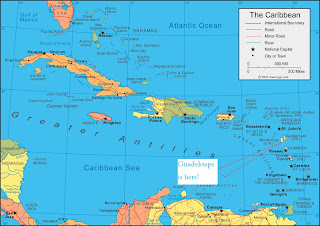
The carambola is a very beautiful fruit, which is mostly used for food decoration or for making refreshing juices (i confirm the last one). I found this carambola-tree covered with fruits in Les Saintes. Another funny thing here is the size of the avocados: they are almost twice or three times bigger than the ones I have seen till now:) One could be up to a kilogram! Even if mostly it is used for salads or salty dishes, the avocado is a fruit, and not a vegetable.

Something pretty new for me is "pomme d eau"(in French, see below), very lovely fruit at first sight, but it tastes watery and has no specific flavour. On the next picture you can see the half of the papaya I have enjoyed this afternoon, very sweet and much more orange than the ones we get in Europe normally.


The world of exotic vegetables is enormous. There are plenty of eatable roots. The most famous Christmas-vegetable is the "igname" (in English: yam), a brownish-black root, which is cooked and prepared as potatoes. I had some today for lunch, it was a puree in a glass in my plate (between the shrimps and the rice). Yams are high in vitamin C, dietary fiber, vitamin B6, potassium, and manganese and because of all this they protect against osteoporosis and heart disease.

Another funny root is the "christophine" (in English: chayote), which looks like a white peer. It is served as gratin and has a very special taste (I personally prefer the yam:-)
Some other typical and widely used roots are the sweet potatoes (patates douce), which have rose colour.


















































-795152.JPG)























